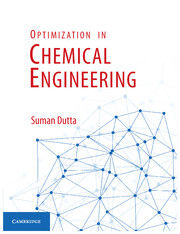Book contents
- Frontmatter
- Dedication
- Contents
- List of Figures
- List of Tables
- Preface
- 1 A Brief Discussion on Optimization
- 2 Formulation of Optimization Problems in Chemical and Biochemical Engineering
- 3 Single Variable Unconstrained Optimization Methods
- 4 Trust-Region Methods
- 5 Optimization of Unconstrained Multivariable Functions
- 6 Multivariable Optimization with Constraints
- 7 Optimization of Staged and Discrete Processes
- 8 Some Advanced Topics on Optimization
- 9 Nontraditional Optimization
- 10 Optimization of Various Chemical and Biochemical Processes
- 11 Statistical Optimization
- 12 Software Tools for Optimization Processes
- Multiple Choice Questions – 1
- Multiple Choice Questions – 2
- Multiple Choice Questions – 3
- Index
- References
1 - A Brief Discussion on Optimization
Published online by Cambridge University Press: 05 February 2016
- Frontmatter
- Dedication
- Contents
- List of Figures
- List of Tables
- Preface
- 1 A Brief Discussion on Optimization
- 2 Formulation of Optimization Problems in Chemical and Biochemical Engineering
- 3 Single Variable Unconstrained Optimization Methods
- 4 Trust-Region Methods
- 5 Optimization of Unconstrained Multivariable Functions
- 6 Multivariable Optimization with Constraints
- 7 Optimization of Staged and Discrete Processes
- 8 Some Advanced Topics on Optimization
- 9 Nontraditional Optimization
- 10 Optimization of Various Chemical and Biochemical Processes
- 11 Statistical Optimization
- 12 Software Tools for Optimization Processes
- Multiple Choice Questions – 1
- Multiple Choice Questions – 2
- Multiple Choice Questions – 3
- Index
- References
Summary
Introduction to Process Optimization
Optimization is a technique of obtaining the best available output for a system or process. The passion for optimality is inherent in human race. Knowingly or unknowingly, we are optimizing our efforts in daily life. This method is studied in every field of engineering, science, and economics. Optimization has been used from ancient times, mostly, by using analytical methods. There are many practical mathematical theories of optimization that have been developed since the sixties when computers become available. The main purpose of the theories is to develop reliable and fast methods to reach the optimum of a function by arranging its evaluations intelligently. Most of the modern engineering and planning applications incorporate optimization process at every step of their complex decision making process. Therefore, this optimization theory is significantly important for them. All of these fields have the same intention like maximization of profit or minimization of cost. As a process engineer, it is our primary concern to utilize resources carefully with minimum loss. An optimized process that use minimum input (raw material, energy, labor etc.) and gives maximum output (product quality and quantity, most environmental friendly) is always favorable. George E Davis extols, “The aim of all chemical procedures should be the utilization of everything and the avoidance of waste. It is often cheaper to prevent waste than to attempt to utilize a waste product.” With proper design of optimized process, wastage of natural resources can be minimized. We can recall the famous quote by Dante “All that is superfluous displeases God and Nature, All that displeases God and Nature is evil.” In nature, everything follows the optimized way to reach the destination. Heat, water etc. flow through the minimum resistance path.
Chemical process industries consist of several “unit operations” and “unit processes” e.g., heat exchanger, distillation column, batch reactor, packed bed reactor, etc. It is the responsibility of a process engineer to run the plant at an optimum condition to obtain the maximum profit with minimum environmental impact. The real driving force for process optimization is efficiency. Chemical companies realize that if they can run the plant more efficiently, it will improve their bottom line. We can optimize the process by considering the individual unit one by one, or by considering many units at a time (e.g., water distribution system with pumps and pipe line, heat exchanger network, reactor network).
- Type
- Chapter
- Information
- Optimization in Chemical Engineering , pp. 1 - 11Publisher: Cambridge University PressPrint publication year: 2016



